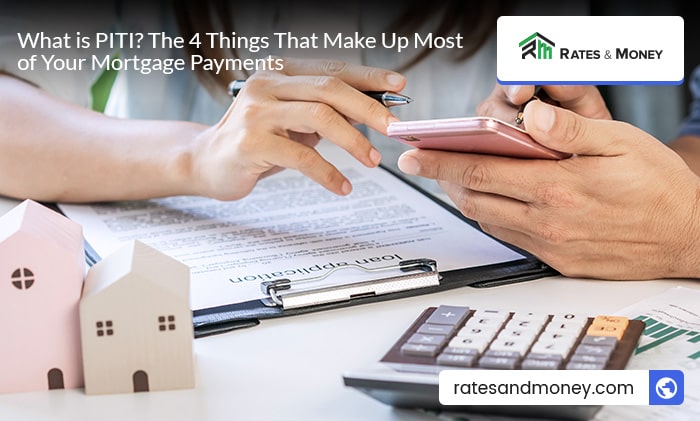What is PITI? The 4 Things That Make Up Most of Your Mortgage Payments

Table of Contents
Your monthly mortgage payment is primarily four things, not just your actual loan payment (although that accounts for two of the things). Your actual total monthly payment is your loan principal, your owed interest, your property taxes, and your homeowner’s insurance.
Right now is a great time to buy a home. Thanks to interest rates being at an all-time low, potential home buyers are on the search and it’s a seller’s market. Before you start exploring open houses, you need to know what your monthly obligation will really be for the home of your dreams.
Since a home purchase is pretty high up on the monthly expenses list for most people, you need to make sure you don’t get overextended. You’ll also need to find out if the loan you’re planning on getting is subject to loan limits, and if so, what those limits are in your area. Your gross monthly income and mortgage interest rate are only the most basic of starting points when deciding how much you can really afford. An affordability calculator can help.
Your official monthly payment to your lender is principal and interest; property taxes, homeowners insurance, homeowner dues (which are HOA fees), and other costs also need to be factored into your overall budget for purchasing a home. A great place to start when computing your potential homeownership expenses is with your PITI.
PITI: The Four Things That Make Up Your Monthly Mortgage Payment
PITI is a mortgage acronym that encompasses the four items that make up your true monthly mortgage obligation:
- Principal
- Interest
- Taxes
- Insurance
Your PITI is calculated monthly, and is the sum of what will be due on your home loan’s principal, interest, taxes, and insurance.
Principal equals the amount of your loan, which starts out as the cost of your home minus your down payment. The principal slowly shrinks over time. If you can make biweekly payments, it shrinks even faster.
Interest is calculated on the remaining principal owed on your home, and is based on the interest rate you locked when you purchased your home if you got a fixed rate mortgage. Interest accounts for a large part of your monthly payment at the beginning of your loan term, but gradually the scale tips the other way and you’ll pay more principal each month. If you get a chance to refinance for a lower interest rate at some point in your loan term, you can save thousands over the life of your loan.
Taxes refers to your property taxes, which may be due annually, but are easier to keep up with if handled monthly. Property taxes can vary greatly depending on where you live and can go up suddenly if land values go up.
Insurance is the last part of PITI. This can include homeowners insurance (usually a requirement from any lender on any type of loan). It may also include Private Mortgage Insurance (PMI) which may be owed if you only have a small down payment and have to finance more than 80% of the home cost. Getting rid of private mortgage insurance is another good reason to refinance your home when you have 20% or more in equity.
The Importance of Understanding PITI
PITI should be considered from the very earliest stages of the home loan process. Your loan officer (LO) can show you how to calculate your estimated PITI using a mortgage calculator. Basically, the PITI is arrived at by dividing your approximate annual property taxes and homeowners insurance into a dozen payments per annum and adding that amount to the principal and interest of your monthly mortgage payment. You’ll need to know your PITI and not just your lender mandated payment that goes directly towards paying off your mortgage.
What To Expect From Taxes and Insurance
Besides your principal and interest payments due each month, you’ll need to be realistic about what your homeowners insurance and property taxes will add to your monthly tab. If property values rise suddenly in your area, your monthly payments could go up. If you have to make a claim against your homeowners insurance, those premiums could also go up. Always build in a buffer when buying a home, so you don’t suddenly find yourself with a total monthly bill that exceeds your capabilities.
PITI and Escrow
Lenders may require that your PITI be paid into an escrow account monthly ahead of your actual due date for your mortgage payment. This is common, especially for first-time homebuyers. Your monthly payment for PITI all goes into your escrow account, and your funds are disbursed for the principal, interest, taxes, insurance and PMI. Funds from this account go to the county for property taxes and your insurance carrier for your homeowner’s insurance as direct disbursements, so you only have to make one monthly payment into the escrow account and everything else is handled automatically.
Calculating Your PITI
Lenders measure your anticipated PITI against your income to determine whether you qualify for a loan. A PITI that roughly a third of your gross monthly income is typically considered best, but lenders have a lot of discretion. If needed, you can make changes on your end by increasing your income, making a higher down payment to reduce the principal and interest payment, or choosing a home within a lower budget.
Ready to Apply For a Home Loan?
Are you curious about mortgage rates, or are you ready to apply for one to buy a home? There are plenty of great mortgage programs available to help you buy the home you’ve always dreamed of. Getting preapproved for a home loan is a great first step.
Rates & Money is your go-to destination for free information about mortgages. Our home buyer guides and home loan articles are designed to help you make informed decisions when buying a home. View loan limits in your area.
Subscribe to our newsletter
Receive the latest news, tips, and free tools from Rates & Money.





